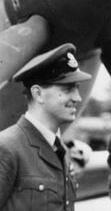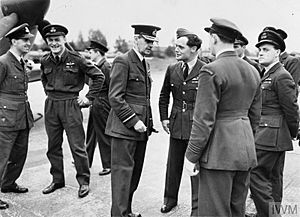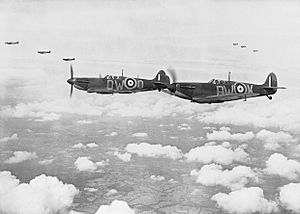John Ellis (RAF officer) facts for kids
Quick facts for kids
John Ellis
|
|
|---|---|
 |
|
| Born | 28 February 1917 Deal, Kent, United Kingdom |
| Died | 19 November 2001 (aged 84) |
| Allegiance | United Kingdom |
| Service/ |
Royal Air Force (1936–1967) |
| Rank | Group Captain |
| Commands held | RAF Molesworth Krendi fighter wing No. 610 Squadron |
| Battles/wars | Second World War |
| Awards | Commander of the Order of the British Empire Distinguished Flying Cross & Bar |
John Ellis CBE, DFC & Bar (born February 28, 1917 – died November 19, 2001) was a brave British pilot in the Royal Air Force (RAF) during the Second World War. He was officially recognized for shooting down at least 13 enemy airplanes.
John Ellis was born in Deal, England. He joined the RAF in 1936. Before the war, he flew with No. 213 Squadron. When the war began, he moved to No. 610 Squadron. This squadron was part of the Auxiliary Air Force.
He flew many missions during the air battles over Dunkirk and in the Battle of Britain. He destroyed several enemy planes during these fights. The next year, he became a flight instructor, first in the UK and then in East Africa. He later returned to flying missions as a wing leader in Malta. He flew missions before the Allied invasion of Sicily. On June 13, 1943, his plane was shot down, and he became a German prisoner of war for the rest of the war.
After the war, he stayed in the RAF. He held various office and training jobs. He also commanded the RAF base at Molesworth for a while. He received the Order of the British Empire award in 1956 and was promoted within the order in 1960. He retired from the RAF in 1967 as a group captain. After leaving the military, he worked as a businessman. John Ellis passed away in 2001 at the age of 83.
Contents
Early Life and Joining the RAF
John Ellis was born in Deal, a town in Kent, on February 28, 1917. After finishing school at Sutton Valence School, he joined the Royal Air Force (RAF) in March 1936. In May, he became a temporary pilot officer after finishing his flight training.
He first joined No. 66 Squadron. Then, in March 1937, he moved to No. 213 Squadron. By this time, he was a confirmed pilot officer. His new squadron had just started again at Northolt with Gloster Gauntlet fighter planes. In July, it moved to Church Fenton. In January 1939, the squadron started using new Hawker Hurricane fighters.
World War II: A Pilot's Story
In September 1939, John Ellis, now a flying officer, joined No. 610 Squadron. This was an Auxiliary Air Force (AAF) squadron. He became one of its flight commanders. Soon after, the squadron began to use Supermarine Spitfire fighters.
The squadron became ready for combat in October. It moved to Wittering and flew patrols along the East Coast. However, they did not see any fighting. In March 1940, Ellis had a small accident when landing his Spitfire. In April and early May, the squadron helped the British forces in Norway. They protected ships crossing the North Sea.
After the German invasion of France, No. 610 Squadron moved south. They joined No. 11 Group at Biggin Hill. From there, they started patrolling the English Channel. At the end of May, British soldiers were trapped at Dunkirk. The squadron flew from Gravesend to protect the beaches during the evacuation. On May 27, Ellis damaged a Messerschmitt Bf 110 heavy fighter. Two days later, he shot down a Messerschmitt Bf 109 fighter over Dunkirk. On the last day of May, he destroyed another Bf 110 near Dunkirk. By this time, Ellis was often leading the squadron on missions.
Fighting in the Battle of Britain
After the soldiers were evacuated from Dunkirk, No. 610 Squadron continued patrolling the English Channel. On June 12, Ellis helped destroy a Heinkel He 111 bomber near Margate. In early July, the squadron moved back to Biggin Hill. From there, they often took off quickly to stop German bombers and their fighter escorts. On July 3, he and other pilots destroyed a Dornier Do 17 bomber near Deal.
He shot down a Bf 109 over Dover on July 24. Later that same day, he destroyed a second Bf 109 near Margate. The next afternoon, Ellis destroyed another Bf 109 near Folkestone. His wingman saw this happen. That evening, Ellis and his flight protected Royal Navy destroyers in the English Channel. They fought 20 German fighters, and Ellis shot down two Bf 109s.
He was promoted to temporary squadron leader and took command of the squadron. On August 12, he shot down two more Bf 109s. The squadron was trying to stop bombers coming towards Dungeness. Only one of these was confirmed, the other was listed as 'probable'. The next day, he received the Distinguished Flying Cross (DFC). This award is for bravery in air combat.
On August 16, Ellis damaged a Junkers Ju 88 bomber. Two days later, on a day known as 'the Hardest Day', the Luftwaffe launched a huge attack. They targeted several airfields in southeast England, including Biggin Hill. Ellis's squadron took off to stop the bombers. He first fought the escorting fighters, destroying a Bf 109. Then he chased the bombers, attacking a He 111 that crashed into the English Channel. He shot down a Bf 109 near Folkestone on August 26. The next day, he shot down a He 111. At the end of August, the squadron moved north to Acklington for a rest.
Later War Service and Capture
At Acklington, Ellis focused on training new pilots for No. 610 Squadron. During this time, he was officially promoted to flight lieutenant. In December, the squadron returned to southern England. They began flying attack missions into France in early 1941, using Spitfire Mk IIs. On March 13, 1941, he destroyed a He 111 off Selsey Bill. This was his last confirmed aerial victory.
In April, Ellis was sent to No. 55 Operational Training Unit (OTU) to teach flying. The next month, he received a bar to his DFC. This meant he had earned the DFC a second time. The award recognized his leadership and bravery.
Towards the end of 1941, Ellis went to East Africa. He continued teaching at No. 71 OTU in Khartoum. In April 1943, Ellis became the leader of the Krendi Wing on the island of Malta. His job was to lead air missions to support the upcoming Allied invasion of Sicily. On June 13, while protecting bombers attacking an airfield, his plane was shot down. He was likely shot down by a German pilot named Gerhard Michalski.
Ellis became a prisoner of war and was held at Stalag Luft III. While imprisoned, he was part of the camp's Escape Committee. He was second-in-charge to Roger Bushell. He taught other prisoners how to survive if they escaped. After several prisoners escaped in March 1944, Ellis became the leader of the Escape Committee. He remained a prisoner until the war ended.
Life After the War

After being freed, John Ellis returned to the United Kingdom. On September 15, 1945, he took part in a special flight over London. This flight celebrated the Battle of Britain. He stayed in the RAF after the war. He was given a permanent position as a squadron leader. He later became a wing commander responsible for training at Fighter Command headquarters.
In 1951, he was promoted to wing commander. He then took charge of the RAF base at Molesworth. He also attended RAF Staff College. Most of his later career in the RAF involved office jobs. In 1956, he was made an officer in the Order of the British Empire. Three years later, he was promoted to group captain. He then became the Senior Personnel Staff Officer at Fighter Command. In 1960, he was promoted again within the Order of the British Empire, becoming a commander.
Ellis retired from the RAF in February 1967, after more than 30 years of service. His last job was at No. 38 Group in Odiham. He then became a businessman until he retired to Hampshire. He passed away on November 19, 2001, at 83 years old. He is officially recognized for shooting down thirteen enemy planes. He also shared one victory with other pilots. He is also credited with one plane probably destroyed and two damaged.


